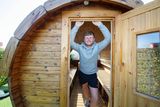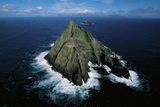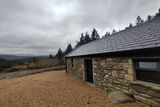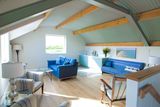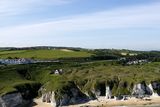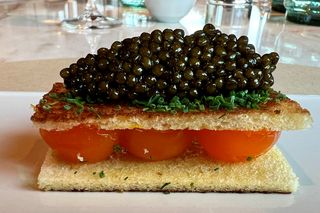Secret Ireland: Inishowen Peninsula
Pól Ó Conghaile goes off the beaten track in search of Donegal’s hidden treasures.
Paddle your own canoe
It's flat calm on Lough Foyle, a perfect day for a paddle. Hooking up with Adrian Harkin of Just Kayak at the Moville waterfront, we pull on wetsuits and life jackets and set out in a bright-yellow sea kayak. The sea looks and feels like syrup.
Sailing north, Donegal is to our left, Derry to our right. Depending on the time you have, Adrian can do hour-long lessons or take groups into the Atlantic and all the way to Malin Head, exploring the cliffs, caves, castles and beaches along this far-flung coastline.
On night-time excursions, he tells me, he has even seen the aurora borealis, or northern lights, flickering in the dark.
All sorts of wildlife nose into Lough Foyle. Cormorants duck and bob around us, and canoeists have encountered bottle-nosed dolphins, seals and basking sharks. "It would set your heart goin', aye," Adrian says, recalling the sensation as one glided towards his kayak with a gaping mouth hoovering up plankton. "But they'd go under you nicely."
Details: €12 per hour, €30 for a half-day. Tel: 074 938 5903; justkayak.ie.
The overnight stay
There's a real shortage of hotels on the Inishowen peninsula, reflecting its off-the-beaten-track location. Getting here, I took the 50-minute flight from Dublin to Derry with Aer Arann, but driving from most parts of the country is a real slog.
It's worth it, though. I book into the Inishowen Gateway Hotel, right on the doorstep of the peninsula in Buncrana and a good base if you're stop-starting along the Inishowen 100. It's a three-star with a decent 20m pool, and on weekends and school holidays a kids' club and facilities such as soft-play areas, Wii and pool tables open up for families.
The hotel looks as if it's about to be eaten by its own car park, but there's lovely service from the receptionist, who puts heating on in the room before I arrive, suggests several activities and calls a cab for my evening out. A solid base.
Details: A spring special including two nights' B&B and one dinner costs from €89pps midweek and €99pps weekends. Tel: 074 936 1144; inishowengateway.com.
The precarious panorama
The northern approach to the Mamore Gap twists like a corkscrew. Out of one window, I can see across the Atlantic Ocean to the frothy surf bashing Malin Head. Out the other, it’s the wispy grass coating the Urris Hills. There’s a real danger of crashing into the scenery.
The Mamore Gap (pictured above and right) slices between two sheets of rock beyond St Colmcille’s Well, where three shrines sit into the scree, littered with weathered rosary beads, baby soothers, dolls, mass cards, a crutch and other petitions and promises.
After squeezing through the gap, the road dips in another scare — a straight 800m descent in the direction of Buncrana. Once upon a time, this mountain pass was used for ambushes. The parish of Urris declared itself a Republic after being fined for potín making in the 1800s, and visiting police were afforded a rocky welcome. It’s a highlight of the Inishowen 100 scenic drive.
Details: discoverireland.ie/northwest.
The forbidding old fort
I catch my breath before stepping across the drawbridge into Fort Dunree. Sure, the last military occupants left in 1986. Sure, the battery never fired a shot in anger. But the chasm separating the rock from the mainland still feels scary, plunging into the violent surf below.
Built on the sight of a fortification erected after Wolfe Tone was captured nearby in 1798, Fort Dunree now looks almost part of the landscape, a squat battery skulking over Lough Swilly below.
Inside, I mosey among brightly painted six-inch guns, a huge German sea mine, old range-finders, searchlights and bunkers where shells once were stocked. It’s not just for military anoraks, however. I also find a sperm whale’s jawbone, a US Navy uniform and a soldier’s ‘housewife’ kit — a canvas washbag containing essentials such as a toothbrush, shaving foam and knife and fork — as well as a series of dramatic coastal walks.
Details: €6/€4. Tel: 074 936 1817; dunree.pro.ie.
The foodie stop
Harrys looks like a nondescript roadhouse in the nondescript town of Bridgend. Step inside, however, and you’ll find three men on a mouth-watering foodie mission.
Almost everything on the menu at Raymond Moran and Donal and Kevin Doherty’s restaurant is sourced from Inishowen.
Think gurnard from Greencastle, game from Inch Island and beef aged for 28 days onsite, right down to venison and rabbit shot by local hunters.
I tuck into the early-bird menu (4pm-9pm, Sunday to Friday), starting with a salty cod cake and seafood cocktail mashing up ling, mullet, crab and onion on a bed of shredded lettuce. Nothing on the black slate plate has travelled further than Greencastle.
Next up it’s loin and belly of pork from Hamilton Farm. Served with a gooey apple and ginger purée, wilted spinach and a mop-up friendly reduction, the belly falls from the fat with a prod of the fork. A side dish of new potatoes in butter and parsley is fresh, hot and floury.
It’s amazing to find such confidence in a town of a few hundred souls — not to mention in Donegal, which isn’t exactly famous for its artisans. I find the large, open room with its burgundy wallpaper and grey walls a little short on atmosphere, but Harrys is terrific value.
Details: A three-course earlybird menu costs €20.
The storytellers of Doagh
I can safely say there is no other museum like Doagh Famine Village in Ireland. Dreamt up by Pat and Majella Doherty, a brother and sister who grew up in one of its white-washed cottages, it tells the story of Doagh and beyond, from the Famine to the financial crisis.
Stepping into the thatched buildings, the exhibits open up like a warren. There’s a traditional kitchen with fireside bed, rabbit traps and oddities such as baby teething rings made from seaweed, just as they were in times gone by. Scenes including a wake, a hedge school and a tenant eviction are staged using an eerie mix of plaster models and department-store mannequins.
In some rooms, my entrance triggers light sensors, opening a settle bed or cupboard to reveal a fright lurking inside.
Elsewhere, I squeeze through hidden passageways in a replica IRA safe house, step into an Orange Hall and pause at a subsiding model of Anglo Irish Bank. Scones and tea are included in the price.
Details: €7. Tel: 074 937 8078; doaghfaminevillage.com.
The hidden treasure
By land, Inishowen is hugely isolated. Due to its strategic position for ships sailing to Scotland and England, however, it boasts a very well-connected maritime heritage. One man from Shrove, the story goes, sailed around the world three times before ever laying eyes on Derry.
Inishowen’s relationship with the sea is celebrated in Greencastle, a fishing village whose small harbour is crammed with colourful trawlers. Here, I stumble on a quirky maritime museum hidden in the old coastguard station. After buying a ticket, the lady raises an electric roller door leading to the exhibits, leaving me face-to-face with a giant model basking shark.
Among the displays are several currachs, a Greencastle yawl (the famous ‘Drontheim’ was once a common sight on Lough Foyle), and artefacts ranging from a corroded radio rescued from a ditched Second World War B-17 bomber, to a framed pair of military-issue boxer shorts recovered by the local sub-aqua club. The surrounding seas clearly have stories to tell.
Details: €5/€3. Tel: 074 9381363; inishowenmaritime.com.
The brisk beach walk
When I mention my travels in Inishowen on Twitter, a handful of locals hit the hashtag, firing off recommendations. One place that crops up several times is Culdaff, a small village fronting on to a Blue Flag beach to the north of the peninsula.
Culdaff itself seems to have expanded generously in the boom years, but that can't spoil the sweeping, sickle-shaped strand nestling nearby. There's just one other person in sight as I walk beneath honey-coloured, 45-degree dunes and a wave peels off in a crescent along the bay.
There's a strange, peaty tinge where it breaks at a river mouth.
During summer, Culdaff beach can get crowded. On a blue-skied spring day, however, it feels wild, lonely and exhilarating. As I leave, a van stacked high with surfboards pulls in.
Details: visitinishowen.com.
Join the Irish Independent WhatsApp channel
Stay up to date with all the latest news

